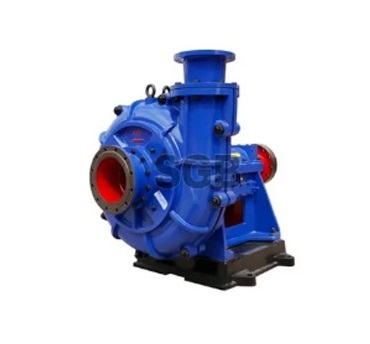Selecting the Right Slurry Pump or Sand Dredge Pump
In various industries, the need for effective material handling is paramount. Whether it's mining, construction, or wastewater treatment, the ability to transport slurry and sand efficiently is crucial. This comprehensive guide explores the importance of slurry pumps and sand dredge pumps in these industries. We'll delve into their functions, applications, and key considerations when selecting the right equipment. Whether you're a professional in the field or simply interested in understanding these essential machines, this guide will provide you with valuable insights.
Slurry Pumps: Handling Abrasive Mixtures with Ease
What Are Slurry Pumps?
Slurry pumps are robust, heavy-duty machines designed to handle the transportation of abrasive and high-density slurries. They consist of a motor, impeller, and various components that enable the pumping of solids-laden fluids with efficiency and reliability. Slurry pumps play a vital role in industries such as mining, mineral processing, and dredging.

How Do Slurry Pumps Work?
China Slurry pumps work on the principle of centrifugal force. The motor drives the impeller, which rotates rapidly, creating a centrifugal force that propels the slurry from the inlet to the outlet of the pump. The impeller's design is crucial in determining the pump's performance, as it must effectively handle the abrasive nature of the slurry while maintaining efficiency.
Key Features and Benefits of Slurry Pumps
Abrasion Resistance: Slurry pumps are specifically designed to handle abrasive materials, such as ore, sand, and gravel. Their wear-resistant materials and robust construction ensure longevity and reduce maintenance requirements.
High Efficiency: Slurry pumps are engineered to deliver high efficiency in transporting slurries. Their design minimizes energy consumption while maximizing the pump's hydraulic performance.
Versatility: Slurry pumps are available in various configurations to meet specific application requirements. They can handle a wide range of flow rates, pressures, and solids concentrations.
Sand Dredge Pumps: Extracting and Transporting Sand with Power
What Are Sand Dredge Pumps?
Sand dredge pumps, also known as sand pumps or dredging pumps, are specially designed to extract sand, sediments, and other solids from bodies of water or the seabed. These pumps are commonly used in dredging projects, beach replenishment, and land reclamation.
How Do Sand Dredge Pumps Work?
Sand dredge pumps work by creating a suction that draws in sand and water through an inlet pipe. The mixture of sand and water, known as the slurry, is then transported through the pump's discharge pipe and discharged at the desired location. Sand dredge pumps are typically equipped with powerful engines to generate the necessary suction and pumping force.
Key Features and Benefits of Sand Dredge Pumps
Powerful Sand Extraction: Sand dredge pumps are designed to handle the extraction of large volumes of sand from various sources. Their robust construction and high-powered engines ensure efficient sand removal.
Additional reading:
How GIM Revolutionizes Plastic Manufacturing: Advantages and Applications
What Is the Fuel Efficiency of Caterpillar Diesel Engines?
What are the different types of hydraulic check valves?
Are Photocatalyst Filters Safe for Indoor Air Purification?
What are the three types of mechanical seals?
Thermal Expansion of Industrial Aluminum Castings
How to Maintain a Kubota Diesel Engine for Optimal Performance?Effective Solids Handling: Sand dredge pumps are equipped with impellers and wear-resistant materials that can handle the abrasive nature of sand and other solids. This allows for continuous operation without clogging or excessive wear.
Versatility and Adaptability: Sand dredge pumps can be used in various environments, including rivers, lakes, and coastal areas. They are available in different sizes and configurations to suit different project requirements.
Selecting the Right Slurry Pump or Sand Dredge Pump
When choosing a slurry pump or sand dredge pump, several factors need to be considered to ensure optimal performance and longevity. Here are some key considerations:
Material Compatibility: Select a pump that is specifically designed to handle the materials you need to transport. Consider factors such as particle size, abrasiveness, and corrosiveness of the materials to determine the most suitable pump materials and design.
Flow Rate and Pressure: Determine the required flow rate and discharge pressure for your application. This will help in selecting a pump with the appropriate capacity and power to meet your needs.
Solids Handling Capacity: Assess the size and concentration of solids in the slurry or sand you need to handle. Choose a pump with an impeller and volute design that can handle the specific solids size and concentration without clogging or excessive wear.
Operational Environment: Consider the environmental conditions in which the pump will operate. Factors such as temperature, humidity, and the presence of corrosive substances can impact the pump's performance and longevity. Select a pump that is designed for the specific operating environment.
Maintenance and Serviceability: Evaluate the ease of maintenance and availability of spare parts for the pump you choose. Opt for pumps from reputable manufacturers with a track record of reliability and excellent after-sales support.
By considering these factors and consulting with pump experts, you can ensure the selection of the most suitable slurry pump or sand dredge pump for your specific needs.
Additional reading:Conventional Plastic Molds for Prototyping: Accelerating Product Development
Are Galvanized Pipe Fittings Right for Retail?
Top Trends in Cast Aluminum Patio Furniture Design
What Factors Can Affect Spring Life?
What are the main applications of Belleville disc springs?
Benefits of Using a Pallet Inverter in Warehouses
Oil Seals - Everything You Need to Know
193
0
0
Related Articles










Comments
All Comments (0)